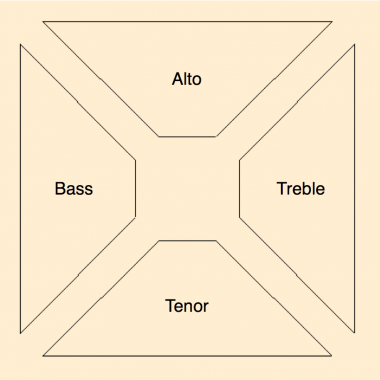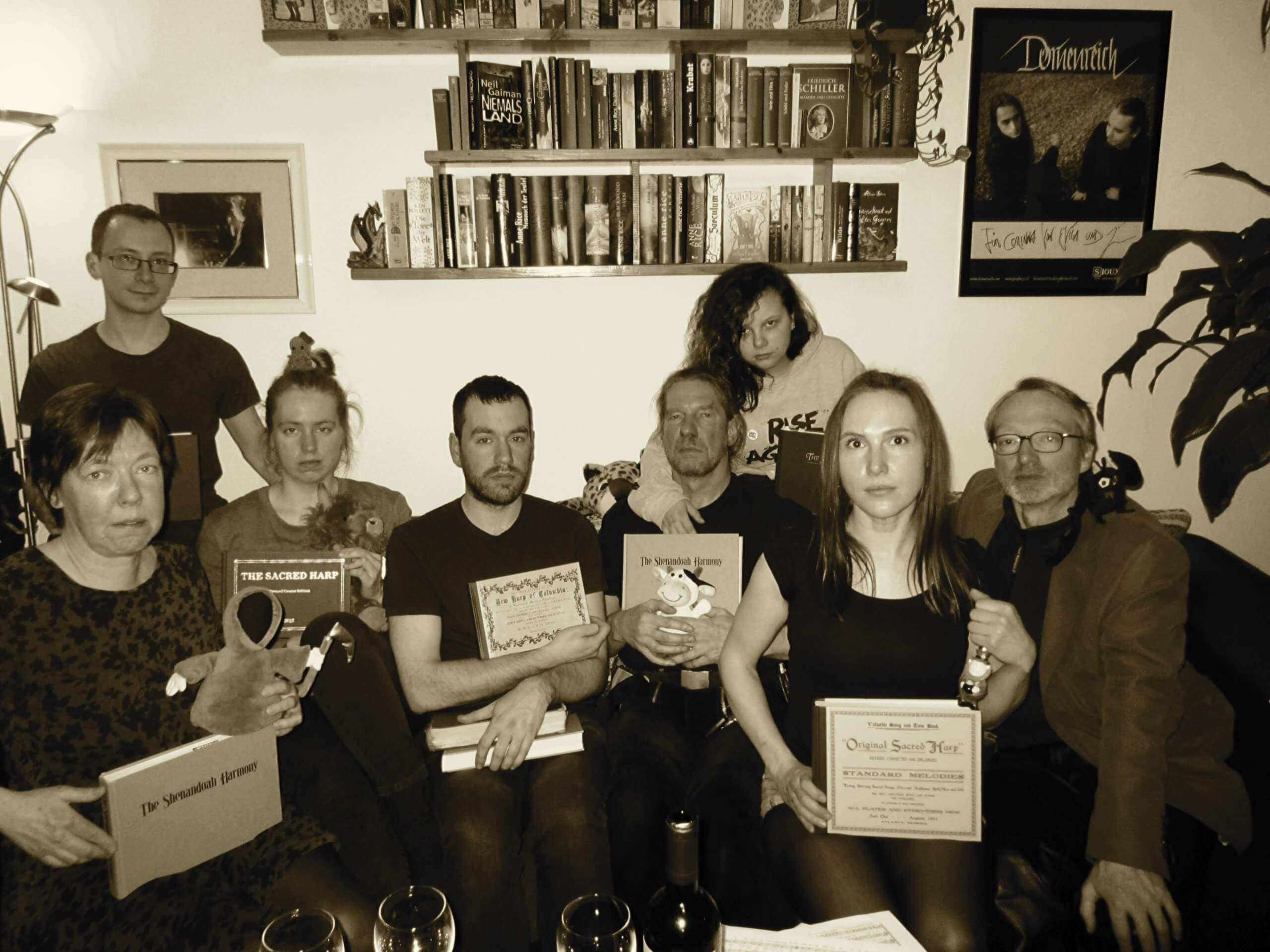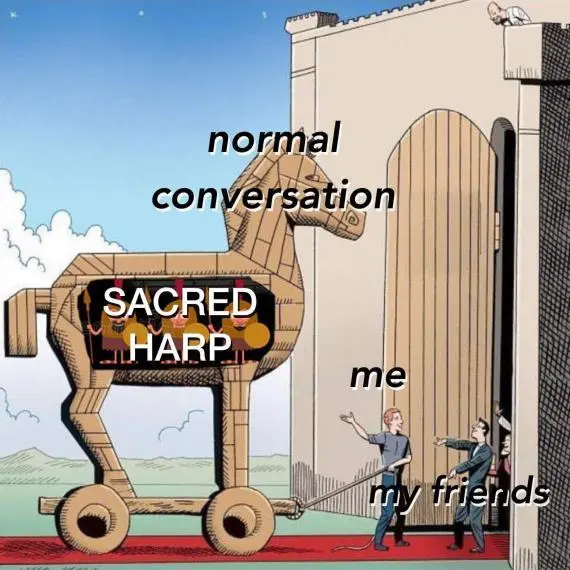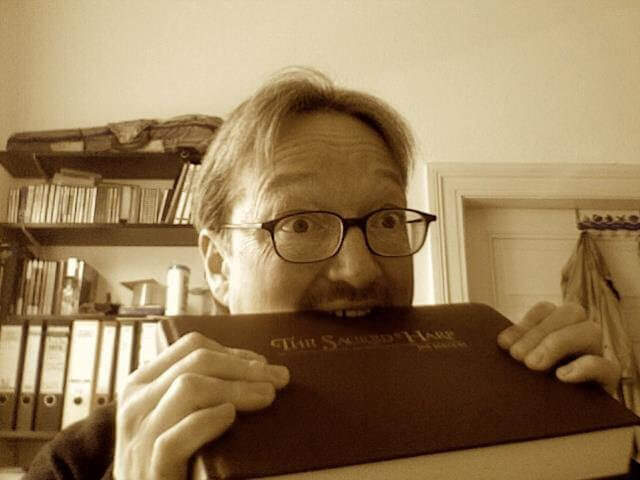What is “Sacred Harp Singing”?
Sacred Harp is DIY choral singing for average people. Powerful, lively, harmonious – and everyone can join in; beginners who have never sung in a choir are welcome. The more participants, the better.
We follow an American tradition from the 19th century that survived in the southern states of the USA and has been gaining popularity again for a few years now, but is still almost unknown in Germany.
We sing in four parts (treble, alto, tenor, bass), sometimes zippy, sometimes “heavy”, always loudly. There is no accompaniment by instruments.
The lyrics, unmistakably Christian, are downright fundamentalist, with “fire and brimstone”. The opinions of most of us may or may not agree with them; at any rate they are of a rough poetry which we enjoy.
Isn’t that the same as gospel?
It’s the precursor, the untamed wild type; think “wolf” instead of “dog”. Here are a few adjectives that may distinguish Sacred Harp from gospel: harsh, passionate, valiant, fiery, unrestrained, melancholic, rousing, sometimes dissonant.
If you are still having the polished sound of trained choir singers in your ear, let us blot out any remaining illusions:
That sounds a bit… weird, but interesting. Can I join in?
Anytime, or rather, once a week in Bremen. Send us a message. Beginners are welcome.
Do I have to audition?
No. You may be asked for your name, if at all. Come in, sit down, that’s all you will have to do.
Do I have to sing along right away?
No. We don’t mind if you remain silent for a while.
Do I have to be able to read music?
No, although it helps if you are. If you stick with us for a while, you’ll learn it automatically, with an amazingly simple method. More on this below (“funny notes”).
What if I don’t have a great voice?
We don’t care at all. Really.
Do you sing for an audience? Do people just come to listen?
You did listen to the video above, right? 😉 We wouldn’t kick anyone out who just wants to listen, but so far everybody actually wants to sing along, and that’s what this music is for.
Should I be able to hum a short simple melody without being too far off?
That would be nice. Don’t worry though, only your self-assessment is needed here; we will not “test” you..
What if I sing out of tune?
No problem, we’ll just drown you out… and we often sing wrong notes, too. It’s not about perfection, it’s about fun. Here you can hear how we mess up the “singing of the notes” (more on that below) and how we deal with it:
I’d like to join in. Can I just drop by, or should I prepare myself somehow?
You can just come along; we don’t mind and won’t ask anything of you. But you probably won’t get much out of just listening to four groups of people shouting at each other.
So we actually recommend a little preparation. What about picking a song and getting familiar with it? If you can, with the notes, otherwise you just learn the melody by heart. A few examples:
49t Old Hundred
159 Wondrous Love
267 Parting Friends (First)
410t The Dying Californian
Thus prepared you show up and tell us what to sing (yes, you can). If you like the experience, you might become eager to learn another song until the next time … and if not, no problem – there is always the process of osmosis between ears and brain. 😉
We don’t want to fool you. If you can’t read music, then it won’t work without a bit of learning, because we don’t sing the party hits that everyone knows. Then again, it’s probably easier than you would think; the melodies are not very difficult, and it’s worth the effort. Polyphonic singing feels great when you are a part of it.
One more hint: If you, like some of us, are a memorizer and can’t do much with notes, look at them anyway when listening to the examples and try to follow the melody on paper or screen. It seems to help with learning. Later you will learn how to look away from the notes when singing in a group.
Do you have an ideological “message”?
No.
Ok, you don’t have an ideological message. But still, these are Christian songs! Are you Christians?
Some of us might be, we don’t know, the group was founded by non-Christians. In any case it doesn’t matter. We meet for the fun of singing and leave religion at the door.
What does it cost to participate?
The rent for our venue is raised by a group of volunteers, each contributing ten euros a month.
Why do you sound so rough? Is this music primitive?
In a way it is primitive, not “produced”, not made supple for easy listening like almost everything you hear on the radio. It’s earthy; it’s real.
Furthermore, no audience is addressed. People sing together, for themselves and for each other. Strong voices, timid voices, it doesn’t matter. There are no professionals and there is no money involved.
Thirdly, the recordings are almost always made by amateurs. Compare your memory of the last concert you attended with a smartphone recording of it. Being there is much better!
Why so loud?
Short answer: because it’s fun.
Why is it fun? Maybe for the same reason that we prefer to listen to rock, techno and metal when it’s played loudly rather than softly. There seems to be at least one theory about this, which has to do with the stimulation of the organ of equilibrium and its close connection to the hypothalamus, which in turn controls our autonomic nervous system, including the sensation of pleasure. If you want to know more, read on here and here. The others may simply believe us – singing Sacred Harp makes you happy. Endorphine gefällig? Endorphins, anyone? Dopamine? Oxytocin is supplied free of charge. Raise your hands.
Someone of you sings the same note off-key in every verse!
There may be at least three reasons.
S/he does not listen carefully,
it’s a “raised sixth,” and … ah, forget about it for now :-),
or the sound is actually meant to be as it is.
Some of the songs are of an astonishing sophistication; whoever invented them obviously had something in mind. Others give the impression that there wasn’t much thinking involved, but they are fun to sing too, maybe all the more.
I listened to your recordings. That’s yelling!
There is no question. 😉
Bad yelling!
We’re bad, we’re nationwide.
You may have fun, but why put it on the net?
Because we can. Because music isn’t just Beethoven, Bach, Pachelbel and perfection. Because we want to show that anyone can join in without fear of being looked at askance for mistakes. No one is forced to listen to it. But come back in a year, maybe we’ll be better then.
Why are the lyrics so morbid? Do you really like singing this?
The words are sometimes almost “gothic”. “Idumea” begins with “And am I born to die…”, and “Calvary” ends with a rich four-part “death!”
They were written in hard times when people lived hard lives and expected improvement only in the hereafter; they tied their hopes to this perspective, supported by singing together. Most people are much better off today, but many still do the same, even if they do not sing.
At least some of our group have a completely different approach; they don’t believe in an afterlife, dedicate their lives to the real world and take the lyrics as a “memento mori”, as the dark background against which the good moments in the here and now shine brighter. When singing, for example.
Why don’t you sing gospel? It’s much sweeter!
That’s why. We avoid anything that even comes close to acoustic cotton candy. To paraphrase, Sacred Harp is whole-grain bread to the ears.
So things are serious with you guys?
On the contrary, there’s a lot to laugh about. Only we don’t fidget around while singing, nor do we clap rhythmically. Some accidental foot stomping may occur though.
And wag your arms?
It’s for keeping time. Looks funny, but works. We encourage our fellow singers to join in, but give no one the hairy eyeball who doesn’t want to. If you want to know more about it, you can read on here.
What does this music remind me of? I can’t figure it out.
Middle Ages and metal. 🙂
Seriously – there are parallels, namely fourths, open fifths (Powerchords) and “riff”-like motifs, as you can hear here:
Why does the first verse sound so much like “blah blah blah oh la la”?
That is solmization, syllables linked to notes. You may have heard of “do re mi fa” etc. (no, etc is not one of them). Sacred Harp only has four, some of which are used twice. The major scale goes like this: “fa so la fa so la la mi fa”.
Why are the tone syllables sung? Isn’t that pretty crazy?
Well. The standard justification is “tradition”, but that wouldn’t convince us either. The tradition comes from the early “Singing Schools” of the American immigrants; it was supposed to help get a feeling for the connection between written notes and sung melody. We sing the “Shapes” (see next question) and can confirm that this actually works.
It is quite fun to sing a verse on those tone syllables, and it has another advantage: the crispiest songs are often the shortest. With “fasola” in front they become longer. Nobody is forced to join in, by the way, and every newcomer has one more opportunity to pick up the melody during the “Shapes” verse.
What are these weird notes?
“Shaped Notes”. They help beginners read music. There are four different forms associated with the tone syllables just mentioned. Here they are:

If you can’t read music, that’s all right. It’s exactly when the shapes help. If you do read music: just ignore the form and read them like normal, “round” notes.
How does the shape of the notes help? I don’t understand that at all.
If we keep hearing melodies and following the notes that go with them, our brain will eventually make a connection. In the case of classical, “round” notes, it is only between the pitch of the note and the position of the note on the staff; in the case of shaped notes, the connection is also established between the pitch and the shape of the note, much like a second sensory channel.
For the most part, this is apparently not a conscious learning process. It is more like learning to ride a bike or ice skating; not a sudden realization, but a process. So the learning effect is not “ah, this is how it works”, but “oops, I can do it!”
Our brain is constantly searching for such connections without us noticing. If it finds any, it triggers the reward system. Here’s a nice video.
If you want to know more (respect!), read on here.
Which part should I sing? Bass? Tenor? Alto? Treble?
Whichever you like. 🙂
Listen to the examples of the individual songs. Try to sing a few notes and compare how it “feels” in the different voice ranges. You will notice which one suits you best.
By the way, there is a trap lurking here. Many beginners do this vocal guesswork at low volume, the same as they use for speaking, and run into a limit with the high notes. Your singing voice goes much further! Find a suitable moment when parents, children, cats and other listeners are out of the house. Begin at talking volume, sing one scale up, starting with the lowest note you can sing comfortably. Now try to put a second scale on top of that first one … and get louder as you do it. Even LOUDER! COME ON! Well?
And now, with this power, let’s go back to the examples. If you have a vocal range like Freddie Mercury (Wow! Join us!) and still can’t decide, then pick the tenor part; it generally has the catchiest melody. You can switch to a different part anytime, even from song to song.
More about vocal ranges here.
When the opening notes of a song are given – which one is mine?
That depends on the song and of course on the part you sing. We usually pitch from low to high; the low note is often for basses and altos, though not always. The higher note is for the tenors, or the altos, or the trebles … you have to look at the written opening notes. The shapes help with that. If “Fa La So Fa” is pitched in ascending order and only one voice has “La” as the first note, the case is clear for them. The same with the “So”.
For those not familiar with music, this sounds Greek. Don’t despair, it changes with time, and before you are there, just listen to your neighbours in the part you’re sitting in; usually we have at least one strong singer in each section who knows what s/he’s doing.
There is no audience? You sing to the wall?
No, we sing for each other, “squared”. Here’s what it looks like:

Why do you never sing the same song twice in one night?
“It’s tradition!” Seriously – if someone at a major singing or convention calls a song that has already been sung that day, a hopefully friendly but determined “used!” will be heard.
In a small group like ours, we could flout this rule, and occasionally we do, but very rarely. Some of us have developed a mentality that seems to be common in the Sacred Harp world; certain people would love to sing new songs all the time. Of course that’s not possible, and even old warhorses get stressed out in the long run if they have to sight read all the time. With time you develop an inner repertoire, you can sing more and more songs half or completely by heart.
Songs seem to have a kind of “shelf life”. If they are new, they may be hard to learn and you quarrel with your own mistakes. But soon you know them by heart, then they are fun. And finally they are subject to wear and tear, some sooner, others later. At some point, we tend to ignore them for weeks and months until one day they resurrect, often to our own surprise.
It’s the mix that matters. New, interesting songs as a challenge. Half known ones that you can “work on” yourself. And old-familiar popular songs that produce a good sound because almost everyone knows them. To sing a song only once is a trade-off between very different needs.
Where can I get the book?
One option is “The Sacred Harp Publishing Company”. The book costs $25 + $5 for shipping in the US, but for Europe 50 (!) dollars shipping costs are added.
If you join our singings regularly, you can take a book home with you. It will cost 30 Euros, which is our cost price including shipping to Europe. You can get started fine without it; we always bring loaner books, and you can download the notes for all songs. Have a look at the sidebar or at this list.
I can’t help it. The religious texts, the fuss with “shaped notes”, the volume, “the book” – all this is very strange. Your emphasis that it’s about participation and that you accept everyone makes me rather sceptical. Are you some kind of cult?
Um… hmm… we do seem to stimulate that impression occasionally.

Perhaps it’s because of our enthusiasm, which sometimes may take on an evangelistic character. We must also admit that Sacred Harp has a certain addictive effect on some of us.

Nevertheless, we are not a cult. Anyone can come and go as s/he pleases, without making any commitments. Any emotional addiction to parallel fifths lies in the responsibility of the participant, but we can assure you that it is not dangerous.
We neither want your soul nor your money, you can keep your friends and family as well. We only want to sing with you.

But you are dogmatic traditionalists?
Strike out “dogmatic”. We follow the Sacred Harp tradition, but we don’t do it because a “guru” prescribes it (there is no such thing). We do it because the method is proven, works and is fun. Maybe it is the easiest existing way to understand and make music yourself.
How do you generate the “robot voices”?
We use Melody Assistant. It comes with a vocal synthesizer, so it’s basically a matter of typing the lyrics under the notes (and tweaking them a bit). Each of the four parts (treble, alto, tenor, bass) is then exported as an AIFF (CD) file. These we feed into GarageBand, do the spacial (not a typo) mix there and export the result as MP3.
Where can I find out more?
In our leaflet, by visiting the links or at one of our singings.
The answer to my question is not there!
Ask your question.
The most asked question: where and when do you sing?
Where and when